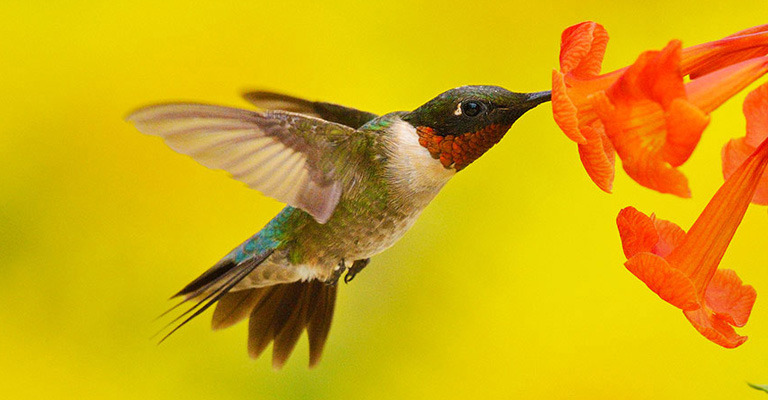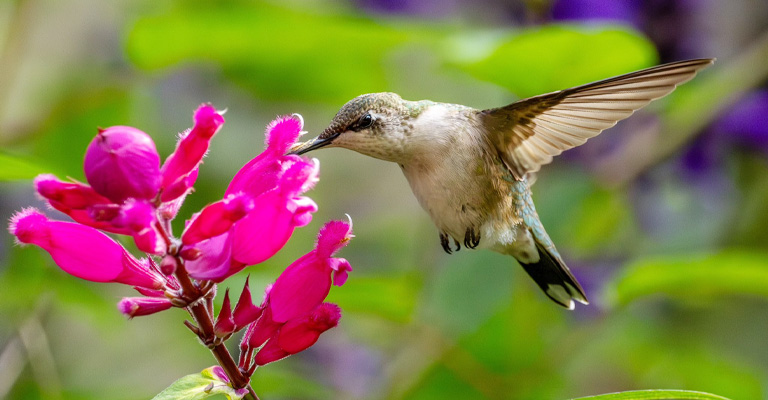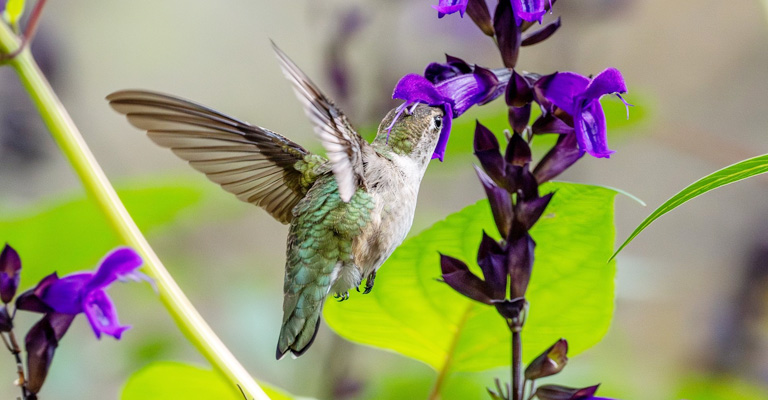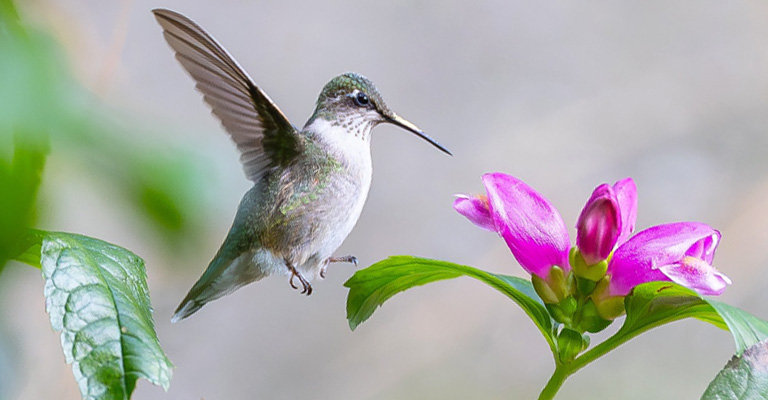The ruby-throated hummingbird, with its iridescent green plumage and the captivating crimson throat patch, stands as a true marvel within the avian kingdom.
These tiny dynamos are renowned for their breathtaking aerial displays, hovering effortlessly while their wings beat in a blur, and darting with astonishing agility.
But what do ruby-throated hummingbirds eat? The answer to this enigma lies in the intricate world of their dietary choices.
In this article, we will embark on a captivating journey to unravel the secrets of what fuels the lives of these remarkable birds.
As we delve into the surprising and multifaceted menu that powers their incredible feats of flight and survival, you’ll gain a deeper appreciation for the complex dietary tapestry that sustains these dazzling birds.
This exploration unveils the remarkable interplay between ruby-throated hummingbirds and the environment, emphasizing their pivotal role in maintaining the ecological balance of the ecosystems they inhabit.

What Do Ruby-Throated Hummingbirds Eat?
While nectar from flowers is ruby-throated hummingbird’s primary energy source, these tiny avian wonders also incorporate a variety of other foods into their diet to meet their nutritional needs.
Let’s find out what ruby-throated hummingbirds eat and how they go about obtaining these vital nutrients.
Nectar: The Mainstay of Their Diet
Nectar is the cornerstone of a ruby-throated hummingbird’s diet, providing the sugars and energy needed for their rapid wing beats and hovering flight.
These agile birds are known for their special relationship with flowers, which produce nectar to attract pollinators. The birds’ long, specialized bills and extendable, tube-like tongues are perfectly designed for extracting nectar from the deep throats of flowers.
Ruby-throated hummingbirds are highly selective when it comes to the flowers they visit. They prefer flowers with tubular shapes and vibrant, often red or orange, colors. Some favorite nectar sources include trumpet vine, bee balm, and red or orange salvias.
They return to these blooms repeatedly, establishing feeding territories and defending them vigorously against intruders.
The Need for More than Nectar

While nectar provides the sugars crucial for their high-energy activities, it lacks the essential proteins, vitamins, and minerals necessary for a balanced diet.
To meet these nutritional needs, ruby-throated hummingbirds also incorporate other food sources into their menu:
Insects
Insects are an excellent source of protein for hummingbirds. These tiny birds are known to catch small insects, such as flies, gnats, and mosquitoes, by darting out from their perches. These insects provide the necessary protein for growth, maintenance, and reproduction.
Hummingbirds also feed on spiders, which are rich in protein. They may pluck spiders from their webs or capture them in mid-air.
Tree Sap
Ruby-throated hummingbirds have been observed tapping into sap wells created by sapsuckers, a type of woodpecker. This sap provides essential minerals and nutrients missing from their nectar-based diet.
Feeding Strategies

To maintain their diet and energy levels, ruby-throated hummingbirds have developed various feeding strategies:
Territorial Behavior
These birds establish and fiercely defend feeding territories, ensuring a reliable supply of nectar. The defense of these territories involves rapid chases, aerial displays, and vocalizations.
Frequency of Feeding
Ruby-throated hummingbirds have fast metabolisms, which necessitate frequent feeding. They visit flowers, and feeders, or catch insects throughout the day, often every 10 to 15 minutes.
Migration and Foraging
During their impressive migrations, ruby-throated hummingbirds rely on nectar-rich flowers as a primary food source. They strategically time their migrations to coincide with the blooming of specific flowers along their routes.
Torpor
To conserve energy during the night or when food sources are scarce, ruby-throated hummingbirds enter a state called torpor. In torpor, their metabolic rate drops significantly, enabling them to survive until better foraging conditions arise.
Conservation and Gardening
Understanding the dietary habits of ruby-throated hummingbirds is essential for their conservation.
As human activities, habitat loss, and climate change impact their food sources, it is crucial to ensure the availability of nectar-rich plants and a reduction in pesticide use.
By planting hummingbird-friendly flowers, providing nectar feeders, and maintaining natural habitats, we can support these incredible birds.
What Is the Lifespan of a Ruby-Throated Hummingbird?

Ruby-throated hummingbirds, with their striking iridescent feathers and incredible agility, are captivating creatures. These tiny birds are a marvel of the avian world, and yet their lifespan is relatively short compared to larger birds.
In this article, we will explore the lifespan of a ruby-throated hummingbird, the factors that influence their longevity, and the challenges they face in their brief lives.
The General Lifespan
The average lifespan of a ruby-throated hummingbird is relatively short, typically ranging from 3 to 5 years. However, some individuals can live longer, while many do not survive their first year. Several factors contribute to this relatively brief existence.
Challenges from the Start
The challenges for a ruby-throated hummingbird begin almost as soon as they hatch. While they are known for their vibrant plumage and stunning aerial displays, they are also small and vulnerable, which makes them susceptible to various threats:
Predators
Hummingbird nests are tiny and well-hidden, but they can still be vulnerable to predators like squirrels, snakes, and even larger birds. Eggs and chicks can fall victim to these threats.
Inclement Weather
Harsh weather conditions, particularly during nesting and migration, can take a toll on hummingbirds. Rain, cold, and wind can be detrimental to their fragile bodies.
Food Scarcity
Finding enough food, primarily nectar-rich flowers, insects, and spiders, is a constant challenge. During unfavorable weather conditions or scarcity of food sources, they may struggle to find enough to sustain themselves.
Territorial Disputes h4 Ruby-throated hummingbirds are fiercely territorial and can engage in intense conflicts to defend their feeding areas. These disputes can result in injuries or even death.
The First Year
The first year of a hummingbird’s life is particularly precarious. Many young hummingbirds do not survive to adulthood, falling victim to any of the threats mentioned above.
Their first migration, which may take them thousands of miles to their wintering grounds, is fraught with danger. Inexperienced birds can become disoriented, run out of energy, or fall prey to predators along the way.
Adult Survival
Once a ruby-throated hummingbird successfully navigates the perils of its first year, it is more likely to survive into adulthood. The average lifespan of an adult ruby-throated hummingbird is around 3 to 5 years, but some individuals have been known to live longer.
Adult hummingbirds continue to face challenges, including territorial disputes, migration, and unpredictable weather. However, their experience and familiarity with their territory and food sources give them an advantage over younger, less experienced birds.
Factors Influencing Longevity
Several factors influence the lifespan of a ruby-throated hummingbird:
Genetics
Some individuals may have genetic advantages that allow them to live longer. These genetic factors can include robust health, disease resistance, or superior foraging skills.
Access to Resources
The availability of reliable food sources is vital. A diet of nectar-rich flowers, insects, and spiders plays a crucial role in their survival. Hummingbirds that can consistently locate and access abundant food are more likely to live longer.
Territorial Success
Dominant hummingbirds that successfully defend their territories tend to have a better chance of survival, especially during the breeding season when access to mates and food sources is essential for reproductive success.
Migration Success
Hummingbirds that can navigate their migration routes successfully, find suitable stopover sites for rest and refueling, and avoid extreme weather conditions are more likely to return to their breeding grounds in good condition, which contributes to their overall longevity.
Disease Resistance
Resistance to diseases, such as avian malaria or other illnesses that can affect hummingbirds, can contribute to longer life spans.
Conservation and Challenges
While the lifespan of a ruby-throated hummingbird is relatively short, there is a role that conservation efforts can play in supporting their populations.
Habitat preservation, including the planting of nectar-rich flowers and the protection of nesting sites, is crucial for their survival.
Reducing the use of pesticides and creating safe environments for foraging and breeding can help mitigate some of the challenges they face.
Understanding the factors that influence their lifespan and taking steps to address these challenges can contribute to the well-being of these remarkable birds.
The brief yet vibrant lives of ruby-throated hummingbirds are a testament to the resilience and adaptability of life in the natural world.
FAQs
Do ruby-throated hummingbirds eat insects?
Yes, they do. In addition to nectar, these hummingbirds also consume insects, which are a vital source of protein in their diet.
What types of flowers attract ruby-throated hummingbirds?
Ruby-throated hummingbirds are attracted to bright, tubular flowers such as red and orange trumpet vines, bee balm, and trumpet-shaped blooms like the trumpet creeper.
How can I provide food for ruby-throated hummingbirds in my garden?
You can attract them by planting nectar-rich flowers, using hummingbird feeders with sugar water, and providing a mix of sugar water (1 part sugar to 4 parts water) in the absence of natural food sources.
Do ruby-throated hummingbirds feed on anything else besides nectar and insects?
While nectar and insects are their primary sources of food, they may occasionally drink tree sap or juice from overripe fruits when available.
How often do ruby-throated hummingbirds need to eat?
Ruby-throated hummingbirds have a high metabolism and need to feed frequently. They can visit up to 1,000 flowers in a day and feed approximately every 10-15 minutes to sustain their energy levels.
Conclusion
The dietary choices of the ruby-throated hummingbird exemplify their extraordinary adaptability and resourcefulness in the face of the challenges posed by their high-energy lifestyle.
While nectar acts as the primary fuel for their rapid wing beats and provides them with the essential sugars needed for their daily endeavors, their ability to diversify their diet to include insects, spiders, and tree sap showcases their unique strategy for obtaining crucial protein and nutrients.
This intricate dietary balance reflects not only the hummingbird’s remarkable physical adaptations but also its profound interdependence with the natural world.
In a delicate dance with the ecosystem, these tiny creatures select their meals meticulously, harmonizing the sweetness of nectar with the nutritional richness of insects and spiders.
Their reliance on this diverse menu underscores their role as key pollinators in the environment, further emphasizing their significance in maintaining the health and biodiversity of local ecosystems.
It’s a beautiful reminder of the wondrous connections that exist between even the tiniest of creatures and the world they inhabit.